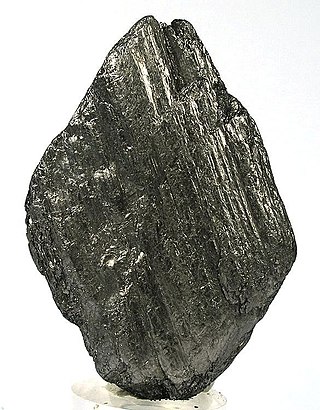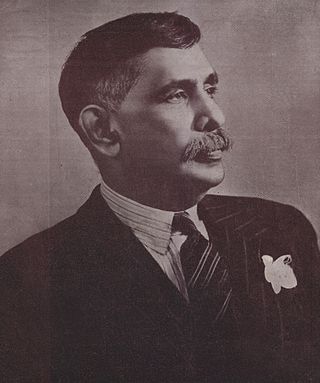Related Research Articles

Graphite is a crystalline form of the element carbon. It consists of stacked layers of graphene. Graphite occurs naturally and is the most stable form of carbon under standard conditions. Synthetic and natural graphite are consumed on a large scale for uses in pencils, lubricants, and electrodes. Under high pressures and temperatures it converts to diamond. It is a good conductor of both heat and electricity.

Don Stephen Senanayake was a Ceylonese statesman. He was the first Prime Minister of Ceylon having emerged as the leader of the Sri Lankan independence movement that led to the establishment of self-rule in Ceylon. He is considered as the "Father of the Nation".

Kegalle is a large town in Sabaragamuwa Province of Sri Lanka. It is located on the Colombo–Kandy road, approximately 78 km (48 mi) from Colombo, 40 km (25 mi) from Kandy, 32 km (20 mi) from Kurunegala and 46 km (29 mi) from Avissavella. It is the main town in the Kegalle District, which is one of two districts which comprise Sabaragamuwa Province. The town is governed by an Urban Council.

General Sir John Lionel Kotelawala was a Sri Lankan statesman, who served as the 3rd Prime Minister of Ceylon from 1953 to 1956.

The Mining industry of Ghana accounts for 5% of the country's GDP and minerals make up 37% of total exports. Gold contributes over 90% of the total mineral exports. Thus, the main focus of Ghana's mining and minerals development industry remains focused on gold. Ghana is Africa's largest gold producer, producing 80.5 t in 2008. Ghana is also a major producer of bauxite, manganese and diamonds. Ghana has 20 large-scale mining companies producing gold, diamonds, bauxite and manganese; over 300 registered small scale mining groups; and 90 mine support service companies. Other mineral commodities produced in the country are natural gas, petroleum, salt, and silver.
Mining of industrial minerals was insignificant to Bhutan’s economy except for the production of ferrosilicon. The country’s rugged terrain provides sites to harvest hydropower, which has driven rapid growth in the transport and construction sectors, including the startup of a number of local cement operations.
Justin Kotelawala, CBE, JP was a Sri Lankan businessman and Senator. He was the former Chairman of the Ceylinco Group.

Maliban Biscuit Manufactories, is one of the largest manufacturers, distributors and marketers of bakery products in Sri Lanka. Maliban is a privately owned limited liability company.

Hayleys PLC, founded in 1878, is a multinational and diversified conglomerate company in Sri Lanka with business spanning over 16 sectors, catering to 70 markets worldwide. Hayleys accounts for approximately 4.2% of Sri Lanka's export income, and 3.9% of the country's tea and 4.5% of its rubber production. With over 30,000 employees, Hayley was also the first listed entity in the country to surpass annual revenue of US$1 billion in Fiscal Year 2017/18. The company operates over 16 business sectors: eco-solutions, hand protection, purification, agriculture, consumer and retail, leisure, textile manufacturing, construction materials, plantations, industrial solutions, power and energy, transportation and logistics, BPO, tea exports, projects and engineering, and investments and services. Hayleys comprises over 130 business units and subsidiaries, nine of which are publicly listed in the Colombo Stock Exchange. In addition to Sri Lanka, Hayleys today has manufacturing facilities in Indonesia and Thailand and marketing operations in Australia, India, Bangladesh, Italy, Japan, Netherlands, UK and USA and its products are sold in 80 countries.
Mining in North Korea is important to the country's economy. North Korea is naturally abundant in metals such as magnesite, zinc, tungsten, and iron; with magnesite resources of 6 billion tonnes, particularly in the North and South Hamgyong Province and Chagang Province. However, often these cannot be mined due to the acute shortage of electricity in the country, as well as the lack of proper tools to mine these materials and an antiquated industrial base. Coal, iron ore, limestone, and magnesite deposits are larger than other mineral commodities. Mining joint ventures with other countries include China, Canada, Egypt, and South Korea.

Mudaliyar Don Spater Senanayake was a Ceylonese, an entrepreneur and philanthropist. He was a successful graphite mine owner and was given the titular title of Mudaliyar for social service by the British colonial administration. He is the father of D. S. Senanayake, the first Prime Minister of Sri Lanka.

Ceylon Steel Corporation is one of the three industrial projects along with Ceylon Tyre Corporation and Ceylon Sugar Corporation, which were established in Sri Lanka by the support of Soviet Union during the Cold War era.

Lanka Graphite Limited is a company engaged in the exploration, development and mining of graphite in Sri Lanka. It was listed on the Australian Securities Exchange in August 2015 and delisted on August 4, 2020
Bothale Walauwa is a large bungalow in Bothale Ihalagama, Western Province, Sri Lanka.
Lakshapathiya Mahavidanalage Jacob De Mel also simply known as V. Jacob De Mel (1839-1919) was a pioneering Ceylonese mining magnate and philanthropist who is still regarded as one of the finest entrepreneurs to have emerged in Sri Lanka. His 100th death anniversary was remembered in Sri Lanka on 1 April 2019, coinciding with April Fools' Day.

The Senanayake family is a Sri Lankan family that is prominent in enterprise and politics. Along with many members who have been successful politician across generations, the family includes two Prime Ministers of Sri Lanka.
Mudaliyar Don Charles Gemoris Attygalle was a Ceylonese entrepreneur and mine owner. He was a successful graphite mine owner and was given the titular title of Mudaliyar for social service by the British Governor of Ceylon. Through the marriage of his daughters, the Senanayake family and the Jayewardene family were connected and played a major part in the Sri Lankan independence movement and in post-independence politics, due in part to the wealth he had accumulated.
Kahatagaha Graphite Mine is a graphite mine located in the village of Kahatagaha in Dodangaslanda in Kurunegala District, North Western Province. It is one of the largest mines in Sri Lanka. Mining started in 1872, under a British owner and was purchased by Don Charles Gemoris Attygalle. It remained in the Attygalle family after the deaths of Don Charles Gemoris Attygalle and his son Francis Dixon Attygalle and was managed by D. S. Senanayake and John Kotelawala until it was nationalised in 1972. Its production dropped after it was taken over by the state due to corruption and mismanagement. Today its managed by the government owned Kahatagaha Graphite Lanka Limited.
Bogala Graphite Mine is a graphite mine located near the village of Aruggammana in Kegalle District, Sabaragamuwa Province. It is one of the largest graphite mines in Sri Lanka, with commercial mining at this location first commencing in 1847.
References
- 1 2 3 4 Mannheimer, E. (1999). Wright, Arnold (ed.). Twentieth Century Impressions of Ceylon: Its History, People, Commerce, Industries, and Resources. Asian Educational Services. p. 585. ISBN 9788120613355.
{{cite book}}:|work=ignored (help) - ↑ "Miscellaneous Documents: 30th Congress, 1st Session - 49th Congress". 40. United States Congress. 1884: 395.
{{cite journal}}: Cite journal requires|journal=(help) - ↑ Jayewardene, Dulip (25 September 2013). "Revival of graphite mining in Sri Lanka – A critical review". Daily Mirror . Retrieved 16 October 2019.
- ↑ Chandrasekera, Duruthu Edirimuni (17 December 2017). "Ceylon Graphite – The new gold". The Sunday Times . Retrieved 16 October 2019.
- ↑ "National Minerals Information Center". U. S. Geological Survey.